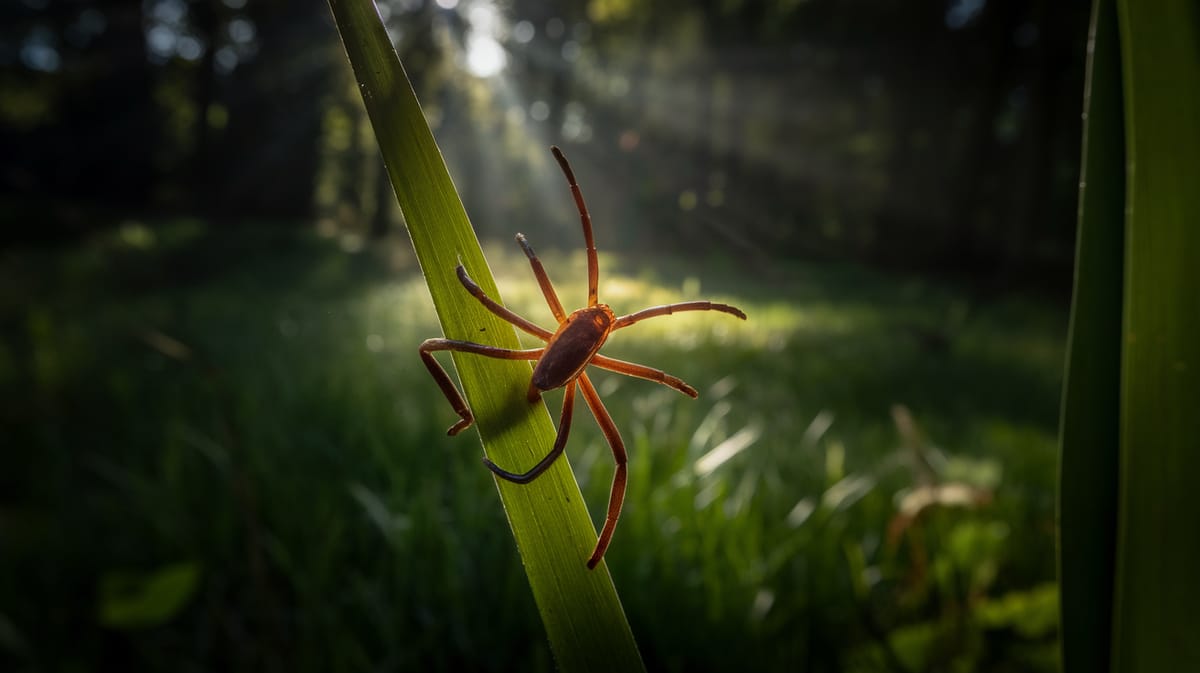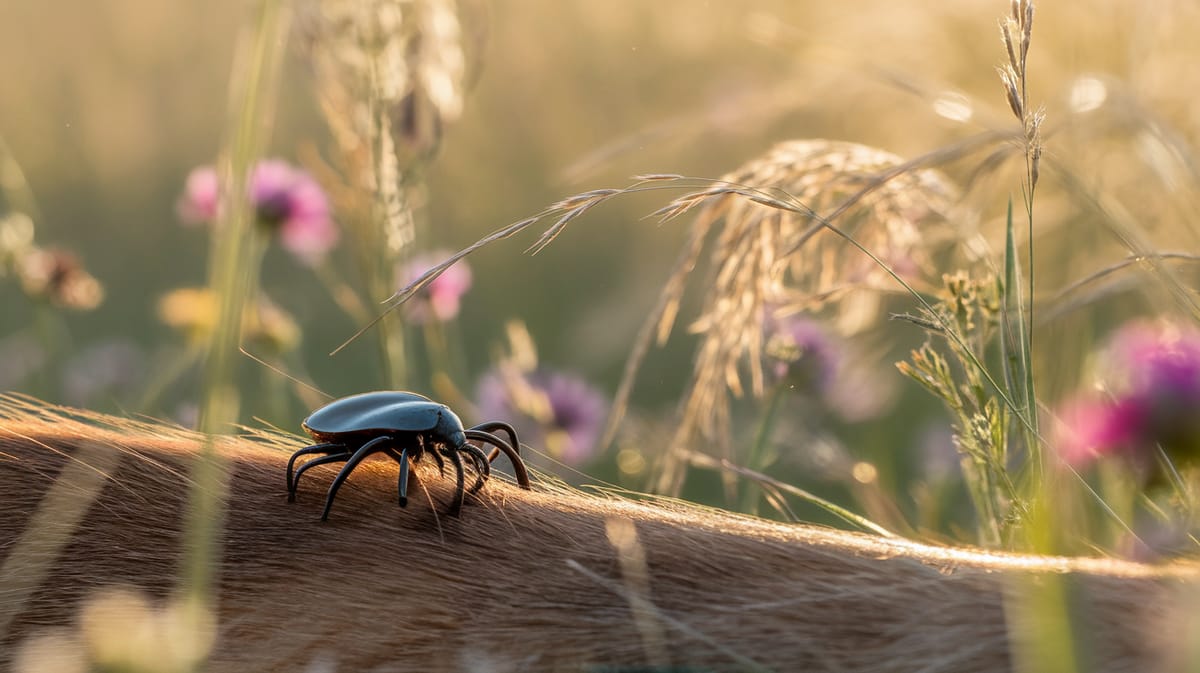Deer Tick
Tiny yet formidable, the Deer Tick quietly waits for its next meal, playing a crucial role in the transmission of Lyme disease. Its persistence in diverse habitats highlights its ecological adaptability.

Key Insights at a Glance
Did You Know?
Taxonomy & Classification
Deer ticks are specialized parasites, adept at stealthy feeding with barbed mouthparts and chemical camouflage, making them efficient vectors for diseases. Let's understand the evolutionary journey and classification of these remarkable parasites.
Global Distribution
Deer ticks, belonging to the genus Ixodes, thrive in temperate regions globally, with around 245 species adapting to diverse environments.
Survival Adaptations
Originating over 90 million years ago, deer ticks evolved antifreeze proteins, enabling survival through glaciation periods and climate shifts.
Lifecycle and Growth
A remarkable journey of transformation from Egg to Adult.
Egg
Laid in sheltered environments, eggs hatch into larvae after a few weeks, beginning the tick's parasitic life cycle.
Larva
Larvae feed on small mammals or birds, accumulating the energy required for their first molt into nymphs.
Nymph
Nymphs seek larger hosts, feeding and growing until ready to molt into adults capable of reproduction.
Adult
Adults feed on larger mammals like deer, with females needing blood meals to produce thousands of eggs.
Dietary Habits
A parasitic feeder with specialized adaptations, this insect relies on blood meals from various vertebrate hosts for survival.
| DIET TYPE | DESCRIPTION |
|---|---|
| Primary Diet | Primarily feeds on the blood of mammals such as deer, rodents, and humans, using its piercing mouthparts. |
| Secondary Diet | Occasionally targets birds and reptiles, especially when mammalian hosts are less accessible. |
| Occasional | Rarely feeds on amphibians, showcasing flexibility in host selection under limited conditions. |

Behaviour and Adaptations
Discover the remarkable capabilities that make the Deer Tick a master of survival.
Heat Detection
Sensitive to host body heat, enabling precise host location for feeding.
Climbing Agility
Expert climbers, easily reaching hosts by scaling tall grasses.
Feeding Efficiency
Efficient blood-feeding mechanism ensures sustained nourishment from hosts.
Ecosystem Impact
The Deer Tick plays a crucial role in maintaining ecological balance and sustainability.
Disease Vector Regulation
Controls vertebrate populations by spreading diseases, influencing species distribution.
Biodiversity Indicator
Presence indicates ecosystem health and biodiversity levels.
Parasite Host
Supports the life cycle of many parasitic organisms, contributing to ecological interactions.
Conservation Challenges
Addressing key threats to Deer Tick populations and their ecosystems.
Chemical Exposure
Pesticides disrupt Deer Tick breeding and survival.
Habitat Loss
Deforestation and urbanization reduce Deer Tick habitats.
Climate Change
Altered temperatures extend Deer Tick active seasons.
Frequently Asked Questions
How long do Deer Tick live?
Deer ticks have a life cycle that lasts about two years. During this time, they go through four stages: egg, larva, nymph, and adult. Their longevity largely depends on environmental conditions and availability of hosts.
What do Deer Tick eat?
Deer ticks primarily feed on the blood of various hosts, including mammals, birds, reptiles, and amphibians. In their larval stage, they often feed on small mammals or birds. Nymphs and adults typically prefer larger hosts like deer or humans.
Are Deer Tick poisonous?
Deer ticks are not poisonous, but they can transmit diseases like Lyme disease, babesiosis, and anaplasmosis through their bites. These diseases are caused by pathogens that are present in the tick's saliva and can be passed to the host during feeding.
Are Deer Tick endangered?
Deer ticks are not considered endangered. They are quite prevalent in many regions, especially in areas with dense vegetation and high humidity, which provide ideal conditions for their survival and reproduction.
What do Deer Tick symbolize?
Deer ticks do not have a widely recognized symbolic meaning. Generally, ticks are often associated with caution due to their role in transmitting diseases. They can also symbolize persistence due to their ability to survive in various environments.
Do Deer Tick bite?
Yes, deer ticks bite to feed on the blood of their hosts. They attach themselves firmly to the skin and can remain attached for several days while feeding. Their bites can be painless, making it easy for them to go unnoticed.
What color are Deer Tick?
Deer ticks are typically reddish-brown in color. Nymphs and larvae may appear lighter, often being a tan or light brown. After feeding, they become engorged and can appear darker, often with a more grayish hue.
Does a Deer Tick have wings?
No, deer ticks do not have wings. They are arachnids and rely on crawling to move from one place to another. They often rely on hosts for transportation to new locations.
What does a Deer Tick look like?
Adult deer ticks are small, about the size of a sesame seed, with a flat, oval shape. They have eight legs and are reddish-brown. Engorged ticks appear larger and darker. Nymphs and larvae are even smaller and lighter in color.
Is a Deer Tick an insect?
No, a deer tick is not an insect. It is an arachnid, closely related to spiders and scorpions. Unlike insects, which have six legs, ticks have eight legs in their nymph and adult stages.
Related Insects
Discover insects with similar characteristics to Deer Tick - including shared habitats, diets, and taxonomic classifications
Share this profile
Help others discover Deer Tick
